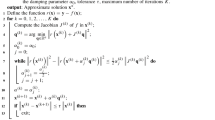Abstract
In the present paper, we propose a numerical method for solving the sparse symmetric Stein equation \(AXA^T-X+BB^T=0.\) Such problems appear in control problems, filtering and image restoration. The proposed method is a Krylov subspace method based on the global Arnoldi algorithm. We apply the global Arnoldi algorithm to extract low-rank approximate solutions to Stein matrix equations. We give some theoretical results and report some numerical experiments to show the effectiveness of the proposed method.
Access this chapter
Tax calculation will be finalised at checkout
Purchases are for personal use only
Similar content being viewed by others
References
Barraud AY (1977) A numerical algorithm to solve A T XA − X = Q. IEEE Trans Autom Contr AC-22:883–885
Bartels RH, Stewart GW (1994) Algorithm 432: Solution of the matrix equation AX + XB = C. Circ Syst and Signal Proc 13:820–826
Calvetti D, Levenberg N, Reichel L (1997) Iterative methods for X − AXB = C. J Comput Appl Math 86:73–101
Datta BN, Datta K (1986) Theoretical and computational aspects of some linear algebra problems in control theory. In: Byrnes CI, Lindquist A (eds) Computational and Combinatorial Methods in Systems Theory. Elsevier, Amsterdam, pp 201–212
Datta BN (2003) Numerical methods for linear control systems design and applications. Academic Press, New York
Davison EJ, Tan FT (1968) The numerical solution of A′Q + QA = − C. IEEE Trans Automat Contr 13:448–449
Golub GH, Nash S, Van Loan C (1979) A Hessenberg-Schur method for the problem AX + XB = C. IEEC Trans Autom Contr AC-24:909–913
Hewer GA (1971) An iterative technique for the computation of steady state gains for the discrete optimal regulator. IEEE Trans Autom Contr AC-16:382–384
Hu DY, Reichel L (1992) Krylov subspace methods for the Sylvester equation. Lin Alg and Appl 174:283–314
Jaimoukha IM, Kasenally EM (1994) Krylov subspace methods for solving large Lyapunov equations. SIAM J Numer Anal 31:227–251
Jbilou K, Messaoudi A, Sadok H (1999) Global FOM and GMRES algorithms for linear systems with multiple right-hand sides. App Num Math 31:49–63
Jbilou K, Riquet AJ (2006) Projection methods for large Lyapunov matrix equations. Lin Alg and Appl 415(2):344–358
Lancaster P, Rodman L (1995) The algebraic Riccati equations. Clarendon Press, Oxford
Li J-R, Wang F, White J (1999) An efficient Lyapunov equation-based approach for generating reduced-order models of interconnect. In: 36th IEEE/ACM Design Automation Conference, New Orleans, LA, pp 1–6
Moore BC (1981) Principal component analysis in linear systems: controllability, observability and model reduction. IEEE Trans Auto Contr AC-26:17–31
Penzl T (2000) A cyclic low-rank Smith method for large sparse Lyapunov equations. SIAM J Sci Comput 21(4):1401–1418
Saad Y (1995) Iterative methods for sparse linear systems. PWS Press, New York
Saad Y (1990) Numerical solution of large Lyapunov equations. In: Kaashoek MA, van Schuppen JH, Ran AC (eds) Signal Processing, Scattering, Operator Theory and Numerical Methods. Proceedings of the international symposium MTNS-89, vol 3. Birkhauser, Boston, pp 503–511
Sadok H (2005) Analysis of the convergence of the minimal and the orthogonal residual methods. Numer Algo 40:201–216
Sima V (1996) Algorithms for Linear-Quadratic Optimization, Pure and applied Mathematics, vol. 200. Marcel Dekker, Inc., New York
Smith RA (1968) Matrix equation XA + BX = C. SIAM J Appl Math 16(1):198–201
Stykel T (2002) Analysis and numerical solution of generalized Lyapunov equations. Dissertation, TU Berlin
Van Dooren P (2000) Gramian based model reduction of large-scale dynamical systems. In: Numerical Analysis. Chapman and Hall/CRC Press, London, pp 231–247
Weyl H (1949) Inequalities between the two kinds of eigenvalues of a linear transformation. Proc Nat Sci USA 30:408–411
Acknowledgements
We would like to thank the referees for helpful remarks and useful suggestions.
Author information
Authors and Affiliations
Corresponding author
Editor information
Editors and Affiliations
Rights and permissions
Copyright information
© 2011 Springer Science+Business Media B.V.
About this chapter
Cite this chapter
Jbilou, K., Messaoudi, A. (2011). A Computational Method for Symmetric Stein Matrix Equations. In: Van Dooren, P., Bhattacharyya, S., Chan, R., Olshevsky, V., Routray, A. (eds) Numerical Linear Algebra in Signals, Systems and Control. Lecture Notes in Electrical Engineering, vol 80. Springer, Dordrecht. https://doi.org/10.1007/978-94-007-0602-6_14
Download citation
DOI: https://doi.org/10.1007/978-94-007-0602-6_14
Published:
Publisher Name: Springer, Dordrecht
Print ISBN: 978-94-007-0601-9
Online ISBN: 978-94-007-0602-6
eBook Packages: EngineeringEngineering (R0)




